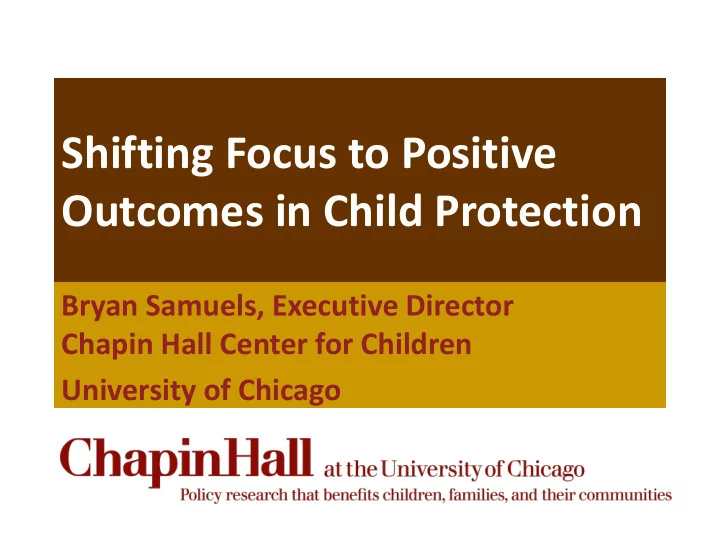

Shifting Focus to Positive Outcomes in Child Protection Bryan Samuels, Executive Director Chapin Hall Center for Children University of Chicago
Guiding Principles of ASFA 1997 • The safety of children is the paramount concern that must guide all child welfare services • Foster care is a temporary setting and not a place for children to grow up • Permanency planning efforts should begin as soon as a child enters the child welfare system • The child welfare system must focus on results and accountability • Innovative approaches are needed to achieve the goals of safety, permanency, and wellbeing
US Out-of-Home Care Declines by 30% 559,000 397,000 FY1998 FY2012
Taking Advantage of ASFA in Illinois 1997 to 2003 51,000 23,400 20,848 1990 1991 1992 1993 1994 1995 1996 1997 1998 1999 2000 2001 2002
Key Policy Changes in Illinois 1. Performance-based contracting with NGOs: – Align performance incentives with ASFA – Reinvestment in high performer – Placement rotation system based on performance 2. Front-end realignment – Standardizing removal criteria 3. Subsidized Adoption and Guardianship
Emotional Distress as Common Insecure Attachments, Emotional Abusive or Neglectful Pathway to Poor Well-being Dysregulation, Negative Parenting Internal Working Models Poor Social-Emotional Functioning, Maladaptive Coping Disturbed/Negative Strategies Relationships Outcomes Poor Adult Psychological Distress Functioning/Outcomes
Developmental Impact of Maltreatment “…maltreatment is not merely a risk factor for later outcomes, but also a causal agent, and, […] its effect is conditioned by the developmental stage at which the maltreatment occurs. Childhood-limited maltreatment significantly affects drug use, problem drug use, suicidal thoughts, and depressive symptoms – reactions to stress that are more inwardly directed. In contrast, maltreatment that occurs in adolescence has a more pervasive effect on early adult development, affecting 10 of the 11 outcomes including involvement in criminal behavior, substance use, health-risking sex behaviors, and suicidal thoughts .” Thornberry, TP; Henry, KL; Ireland, TO & Smith, CA. (2010). The causal impact of childhood-limited maltreatment and adolescent maltreatment on early adult adjustment. Journal of Adolescent Health . 46:359.
Developmental Impact of Maltreatment Behavioral and Emotional Reactions Immediate Behavioral Reactions Delayed Behavioral Reactions Startled reaction Avoidance of event reminders Restlessness Social relationship disturbances Sleep and appetite disturbances Decreased activity level Difficulty expressing oneself Engagement in high-risk behaviors Argumentative behavior Increased use of alcohol, drugs, and tobacco Withdrawal and apathy Withdrawal Avoidant behaviors Immediate Emotional Reactions Delayed Emotional Reactions Numbness and detachment Irritability and/or hostility Anxiety or severe fear Depression Guilt (including survivor guilt) Mood swings, instability Exhilaration as a result of surviving Anxiety (e.g., phobia, generalized anxiety) Fear of Anger trauma recurrence Sadness Grief reactions Helplessness Shame Feeling unreal; depersonalization (e.g., feeling as if Feelings of fragility and/or vulnerability you are watching yourself) Disorientation Feeling out of control Emotional detachment from anything that requires Denial emotional reactions (e.g., significant and/or family Constriction of feelings reactions to them) Feeling relationships, conversations about self, discussion overwhelmed of traumatic events or Sources: Briere & Scott, 2006b; Foa, Stein, & McFarlane, 2006; Pietrzak, Goldstein, Southwick, & Grant, 2011.
Impact of Maltreatment on Child Well-being: Physical and Cognitive Reactions Immediate Physical Reactions Delayed Physical Reactions Nausea and/or gastrointestinal distress Sleep disturbances, nightmares Sweating or shivering Somatization Faintness Appetite and digestive changes Muscle tremors or uncontrollable shaking Lowered resistance to colds and infection Elevated heartbeat, respiration, and blood pressure Hyperarousal Extreme fatigue or exhaustion Elevated cortisol levels Greater startle responses Persistent fatigue Depersonalization Long-term health effects including heart, liver, autoimmune, and pulmonary disease Immediate Cognitive Reactions Delayed Cognitive Reactions Difficulty concentrating Intrusive memories or flashbacks Rumination or racing thoughts Reactivation of previous traumatic events Distortion of time and space Self-blame Memory problems Preoccupation with event Difficulty making decisions Magical thinking: belief that certain behaviors will protect against future trauma Belief that feelings or memories are dangerous Generalization of triggers Suicidal thinking Sources: Briere & Scott, 2006b; Foa, Stein, & McFarlane, 2006; Pietrzak, Goldstein, Southwick, & Grant, 2011.
Learning from Past and Shifting Focus on Positive Child Outcomes (Well-being) Lessons Learned from 1997-2003 • Focusing on permanency benefits most children and youth in care; • Longer lengths of stay exacerbate adverse childhood experiences for all children who remain in care; • Performance-based contacting, adoption and guardianship subsidies led to greater permanency and financial savings, not well-being; • Older youth face significant challenges to achieve independence; Goals for Lifetime Approach • Address interpersonal trauma . • Improved independent living skills/coping skills. • Promote success in school and community . • Focus on building relationships . • Continue to seek permanent families for all.
Focusing on Improved Functioning in Key Domains of Child’s Life The framework identifies four basic domains of well being: (a) cognitive functioning, (b) physical health and development, (c) behavioral/emotional functioning, and (d) social functioning. Within each domain, the characteristics of healthy functioning related directly to how children and youth navigate their daily lives : how they engage in relationships, cope with challenges, and handle responsibilities. Physical Cognitive Health and Functioning Development Environmental Personal Supports Characteristics Emotional/ Social Behavioral Functioning Functioning Developmental Stage
Recommend
More recommend